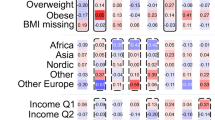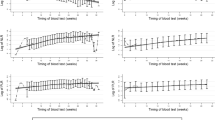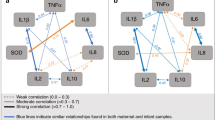Abstract
Background/Objectives:
Maternal obesity may influence neonatal and childhood morbidities through increased inflammation and/or altered immune response. Less is known about paternal obesity. We hypothesized that excessive parental weight contributes to elevated inflammation and altered immunoglobulin (Ig) profiles in neonates.
Subjects/Methods:
In the Upstate KIDS Study maternal pre-pregnancy body mass index (BMI) was obtained from vital records and paternal BMI from maternal report. Biomarkers were measured from newborn dried blood spots (DBS) among neonates whose parents provided consent. Inflammatory scores were calculated by assigning one point for each of five pro-inflammatory biomarkers above the median and one point for an anti-inflammatory cytokine below the median. Linear regression models and generalized estimating equations were used to estimate mean differences (β) and 95% confidence intervals (CI) in the inflammatory score and Ig levels by parental overweight/obesity status compared with normal weight.
Results:
Among 2974 pregnancies, 51% were complicated by excessive maternal weight (BMI>25), 73% by excessive paternal weight and 28% by excessive gestational weight gain. Maternal BMI categories of overweight (BMI 25.0–29.9) and obese class II/III (BMI≥35) were associated with increased neonatal inflammation scores (β=0.12, 95% CI: 0.02, 0.21; P=0.02 and β=0.13, CI: −0.002, 0.26; P=0.05, respectively) but no increase was observed in the obese class I group (BMI 30–34.9). Mothers with class I and class II/III obesity had newborns with increased IgM levels (β=0.11, CI: 0.04, 0.17; P=0.001 and β=0.12, CI: 0.05, 0.19); P<0.001, respectively). Paternal groups of overweight, obese class I and obese class II/III had decreased neonatal IgM levels (β=−0.08, CI: −0.13,−0.03, P=0.001; β=−0.07, CI: −0.13, −0.01, P=0.029 and β=−0.11, CI:−0.19,−0.04, P=0.003, respectively).
Conclusions:
Excessive maternal weight was generally associated with increased inflammation and IgM supporting previous observations of maternal obesity and immune dysregulation in offspring. The role of paternal obesity requires further study.
This is a preview of subscription content, access via your institution
Access options
Subscribe to this journal
Receive 12 print issues and online access
$259.00 per year
only $21.58 per issue
Buy this article
- Purchase on Springer Link
- Instant access to full article PDF
Prices may be subject to local taxes which are calculated during checkout
Similar content being viewed by others
References
Centers for Disease and Control and Prevention. Centers for Disease Control and Prevention; PRAMStat 2011 (cited 2016 February 11, 2016). Available from: http://nccd.cdc.gov/PRAMStat/rdPage.aspx?rdReport=DRH_PRAMS.ExploreByTopic&islClassId=CLA9&islTopicId=TOP31&go=GO.
Labayen I, Ruiz JR, Ortega FB, Loit HM, Harro J, Veidebaum T et al. Intergenerational cardiovascular disease risk factors involve both maternal and paternal BMI. Diabetes Care 2010; 33: 894–900.
Soubry A, Murphy SK, Wang F, Huang Z, Vidal AC, Fuemmeler BF et al. Newborns of obese parents have altered DNA methylation patterns at imprinted genes. Int J Obes (Lond) 2015; 39: 650–657.
Avci ME, Sanlikan F, Celik M, Avci A, Kocaer M, Gocmen A . Effects of maternal obesity on antenatal, perinatal and neonatal outcomes. J Matern Fetal Neonatal Med 2015; 28: 2080–2083.
Bodnar LM, Siminerio LL, Himes KP, Hutcheon JA, Lash TL, Parisi SM et al. Maternal obesity and gestational weight gain are risk factors for infant death. Obesity 2016; 24: 490–498.
The American College of Obstetrics and Gynecologists. Frequently Asked Questions; FAQ 182; Pregnancy 2013 [updated June 2013; cited 2016 Freburary 11, 2016]. Available from https://www.acog.org/-/media/For-Patients/faq182.pdf?dmc=1&ts=20160211T1232285230.
Suk D, Kwak T, Khawar N, VanHorn S, Salafia CM, Narula P . Increasing maternal body mass index during pregnancy increases neonatal intensive care unit admission in near and full-term infants. J Matern Fetal Neonatal Med 2015; 29: 3249–3253.
Yu Z, Han S, Zhu J, Sun X, Ji C, Guo X . Pre-pregnancy body mass index in relation to infant birth weight and offspring overweight/obesity: a systematic review and meta-analysis. PLOS One 2013; 8: e61627.
Catalano PM, Farrell K, Thomas A, Huston-Presley L, Mencin P, de Mouzon SH et al. Perinatal risk factors for childhood obesity and metabolic dysregulation. Am J Clin Nutr 2009; 90: 1303–1313.
Rizzo GS, Sen S . Maternal obesity and immune dysregulation in mother and infant: A review of the evidence. Paediatr Respir Rev 2015; 16: 251–257.
Lieb W, Pencina MJ, Lanier KJ, Tofler GH, Levy D, Fox CS et al. Association of parental obesity with concentrations of select systemic biomarkers in nonobese offspring: the Framingham Heart Study. Diabetes 2009; 58: 134–137.
Leibowitz KL, Moore RH, Ahima RS, Stunkard AJ, Stallings VA, Berkowitz RI et al. Maternal obesity associated with inflammation in their children. World J Pediatr 2012; 8: 76–79.
Intstitute of Medicine, National Research Council Weight Gain During Pregnancy. Reexamining the Guidelines: Washington, DC, USA, 2009.
Chen A, Feresu SA, Fernandez C, Rogan WJ . Maternal obesity and the risk of infant death in the United States. Epidemiology 2009; 20: 74–81.
Durie DE, Thornburg LL, Glantz JC . Effect of second-trimester and third-trimester rate of gestational weight gain on maternal and neonatal outcomes. Obstet Gynecol 2011; 118: 569–575.
Samuelsson AM, Matthews PA, Argenton M, Christie MR, McConnell JM, Jansen EH et al. Diet-induced obesity in female mice leads to offspring hyperphagia, adiposity, hypertension, and insulin resistance: a novel murine model of developmental programming. Hypertension 2008; 51: 383–392.
Ludwig DS, Rouse HL, Currie J . Pregnancy weight gain and childhood body weight: a within-family comparison. PLoS Med 2013; 10: e1001521.
Martino J, Sebert S, Segura MT, Garcia-Valdes L, Florido J, Padilla MC et al. Maternal body weight and gestational diabetes differentially influence placental and pregnancy outcomes. J Clin Endocrinol Metab 2015; 101: 59–68.
Heerwagen MJ, Miller MR, Barbour LA, Friedman JE . Maternal obesity and fetal metabolic programming: a fertile epigenetic soil. Am J Physiol Regul Integr Comp Physiol 2010; 299: R711–R722.
Aye IL, Lager S, Ramirez VI, Gaccioli F, Dudley DJ, Jansson T et al. Increasing maternal body mass index is associated with systemic inflammation in the mother and the activation of distinct placental inflammatory pathways. Biol Reprod 2014; 90: 129.
Ingvorsen C, Brix S, Ozanne SE, Hellgren LI . The effect of maternal Inflammation on foetal programming of metabolic disease. Acta Physiol 2015; 214: 440–449.
Ekstrom S, Magnusson J, Kull I, Lind T, Almqvist C, Melen E et al. Maternal body mass index in early pregnancy and offspring asthma, rhinitis and eczema up to 16 years of age. Clin Exp Allergy 2015; 45: 283–291.
Kumar R, Story RE, Pongracic JA, Hong X, Arguelles L, Wang G et al. Maternal pre-pregnancy obesity and recurrent wheezing in early childhood. Pediatr Allergy Immunol Pulmonol 2010; 23: 183–190.
Whitaker RC, Wright JA, Pepe MS, Seidel KD, Dietz WH . Predicting obesity in young adulthood from childhood and parental obesity. N Engl J Med 1997; 337: 869–873.
Binder NK, Sheedy JR, Hannan NJ, Gardner DK . Male obesity is associated with changed spermatozoa Cox4i1 mRNA level and altered seminal vesicle fluid composition in a mouse model. Mol Hum Reprod 2015; 21: 424–434.
Bromfield JJ, Schjenken JE, Chin PY, Care AS, Jasper MJ, Robertson SA . Maternal tract factors contribute to paternal seminal fluid impact on metabolic phenotype in offspring. Proc Natl Acad Sci USA 2014; 111: 2200–2205.
Ness AR, Griffiths AE, Howe LD, Leary SD . Drawing causal inferences in epidemiologic studies of early life influences. Am J Clin Nutr 2011; 94: 1959S–1963S.
Buck Louis GM, Hediger ML, Bell EM, Kus CA, Sundaram R, McLain AC et al. Methodology for establishing a population-based birth cohort focusing on couple fertility and children's development, the Upstate KIDS Study. Paediatr Perinat Epidemiol 2014; 28: 191–202.
Yeung EH, Louis GB, Lawrence D, Kannan K, McLain AC, Caggana M et al. Eliciting parental support for the use of newborn blood spots for pediatric research. BMC Med Res Methodol 2016; 16: 14.
Centers for Disease and Control and Prevention. About Adult BMI (updated May 15, 2015; cited 2016 March 11, 2016). Available from http://www.cdc.gov/healthyweight/assessing/bmi/adult_bmi/index.html.
Andersen NJ, Mondal TK, Preissler MT, Freed BM, Stockinger S, Bell E et al. Detection of immunoglobulin isotypes from dried blood spots. J Immunol Methods 2014; 404: 24–32.
Leek JT, Johnson WE, Parker HS, Jaffe AE, Storey JD . The sva package for removing batch effects and other unwanted variation in high-throughput experiments. Bioinformatics 2012; 28: 882–883.
Core Team. R, R . A Language and Environment for Statistical Computing. R Foundtion for Statistical Computing: Vienna, Austria, 2016. URL https://www.R-project.org/.
Opal SM, DePalo VA . Anti-inflammatory cytokines. Chest 2000; 117: 1162–1172.
Sarandakou A, Giannaki G, Malamitsi-Puchner A, Rizos D, Hourdaki E, Protonotariou E et al. Inflammatory cytokines in newborn infants. Mediators Inflamm 1998; 7: 309–312.
Pellanda LC, Duncan BB, Vigo A, Rose K, Folsom AR, Erlinger TP et al. Low birth weight and markers of inflammation and endothelial activation in adulthood: the ARIC study. Int J Cardiol 2009; 134: 371–377.
Stewart FM, Freeman DJ, Ramsay JE, Greer IA, Caslake M, Ferrell WR . Longitudinal assessment of maternal endothelial function and markers of inflammation and placental function throughout pregnancy in lean and obese mothers. J Clin Endocrinol Metab 2007; 92: 969–975.
Ramsay JE, Ferrell WR, Crawford L, Wallace AM, Greer IA, Sattar N . Maternal obesity is associated with dysregulation of metabolic, vascular, and inflammatory pathways. J Clin Endocrinol Metab 2002; 87: 4231–4237.
Madan JC, Davis JM, Craig WY, Collins M, Allan W, Quinn R et al. Maternal obesity and markers of inflammation in pregnancy. Cytokine 2009; 47: 61–64.
Basu S, Haghiac M, Surace P, Challier JC, Guerre-Millo M, Singh K et al. Pregravid obesity associates with increased maternal endotoxemia and metabolic inflammation. Obesity 2011; 19: 476–482.
Girard S, Sebire G . Transplacental transfer of Interleukin-1 receptor agonist and antagonist following maternal immune activation. Am J Reprod Immunol 2016; 75: 8–12.
Zaretsky MV, Alexander JM, Byrd W, Bawdon RE . Transfer of inflammatory cytokines across the placenta. Obstet Gynecol 2004; 103: 546–550.
Wienecke J, Hebel K, Hegel KJ, Pierau M, Brune T, Reinhold D et al. Pro-inflammatory effector Th cells transmigrate through anti-inflammatory environments into the murine fetus. Placenta 2012; 33: 39–46.
Soubry A, Schildkraut JM, Murtha A, Wang F, Huang Z, Bernal A et al. Paternal obesity is associated with IGF2 hypomethylation in newborns: results from a Newborn Epigenetics Study (NEST) cohort. BMC Med 2013; 11: 29.
Ben-Hur H, Gurevich P, Elhayany A, Avinoach I, Schneider DF, Zusman I . Transport of maternal immunoglobulins through the human placental barrier in normal pregnancy and during inflammation. Int J Mol Med 2005; 16: 401–407.
Avrech OM, Samra Z, Lazarovich Z, Caspi E, Jacobovich A, Sompolinsky D . Efficacy of the placental barrier for immunoglobulins: correlations between maternal, paternal and fetal immunoglobulin levels. Int Arch Allergy Immunol 1994; 103: 160–165.
Peters JL, Cohen S, Staudenmayer J, Hosen J, Platts-Mills TA, Wright RJ . Prenatal negative life events increases cord blood IgE: interactions with dust mite allergen and maternal atopy. Allergy 2012; 67: 545–551.
Seydel LS, Petelski A, van Dam GJ, van der Kleij D, Kruize-Hoeksma YC, Luty AJ et al. Association of in utero sensitization to Schistosoma haematobium with enhanced cord blood IgE and increased frequencies of CD5- B cells in African newborns. Am J Trop Med Hyg 2012; 86: 613–619.
Annesi-Maesano I, Pollitt R, King G, Bousquet J, Hellier G, Sahuquillo J et al. In utero exposure to lead and cord blood total IgE. Is there a connection? Allergy 2003; 58: 589–594.
Pike KC, Inskip HM, Robinson SM, Cooper C, Godfrey KM, Roberts G et al. The relationship between maternal adiposity and infant weight gain, and childhood wheeze and atopy. Thorax 2013; 68: 372–379.
Haberg SE, Stigum H, London SJ, Nystad W, Nafstad P . Maternal obesity in pregnancy and respiratory health in early childhood. Paediatr Perinat Epidemiol 2009; 23: 352–362.
Forno E, Young OM, Kumar R, Simhan H, Celedon JC . Maternal obesity in pregnancy, gestational weight gain, and risk of childhood asthma. Pediatrics 2014; 134: e535–e546.
Bolte G, Schmidt M, Maziak W, Keil U, Nasca P, von Mutius E et al. The relation of markers of fetal growth with asthma, allergies and serum immunoglobulin E levels in children at age 5–7 years. Clin Exp Allergy 2004; 34: 381–388.
Wellek B, Hahn H, Opferkuch W . Opsonizing activities of IgG, IgM antibodies and the C3b inactivator-cleaved third component of complement in macrophage phagocytosis. Agents Actions 1976; 6: 260–262.
Kankuri E, Kurki T, Carlson P, Hiilesmaa V . Incidence, treatment and outcome of peripartum sepsis. Acta Obstet Gynecol Scand A 2003; 82: 730–735.
Hooijkaas H, Benner R, Pleasants JR, Wostmann BS . Isotypes and specificities of immunoglobulins produced by germ-free mice fed chemically defined ultrafiltered ‘antigen-free’ diet. Eur J Immunol 1984; 14: 1127–1130.
Wang C, Turunen SP, Kummu O, Veneskoski M, Lehtimaki J, Nissinen AE et al. Natural antibodies of newborns recognize oxidative stress-related malondialdehyde acetaldehyde adducts on apoptotic cells and atherosclerotic plaques. Int Immunol 2013; 25: 575–587.
Chou MY, Fogelstrand L, Hartvigsen K, Hansen LF, Woelkers D, Shaw PX et al. Oxidation-specific epitopes are dominant targets of innate natural antibodies in mice and humans. J Clin Invest 2009; 119: 1335–1349.
Chiesa C, Signore F, Assumma M, Buffone E, Tramontozzi P, Osborn JF et al. Serial measurements of C-reactive protein and interleukin-6 in the immediate postnatal period: reference intervals and analysis of maternal and perinatal confounders. Clin Chem 2001; 47: 1016–1022.
Acknowledgements
Supported by the Intramural Research Program of the Eunice Kennedy Shriver National Institute of Child Health and Human Development (NICHD; contracts #HHSN275201200005C, #HHSN267200700019C). The authors thank all the Upstate KIDS participants and staff for their important contributions.
Author information
Authors and Affiliations
Corresponding author
Ethics declarations
Competing interests
The authors declare no conflict of interest.
Additional information
Supplementary Information accompanies this paper on International Journal of Obesity website
Supplementary information
Rights and permissions
About this article
Cite this article
Broadney, M., Chahal, N., Michels, K. et al. Impact of parental obesity on neonatal markers of inflammation and immune response. Int J Obes 41, 30–37 (2017). https://doi.org/10.1038/ijo.2016.187
Received:
Revised:
Accepted:
Published:
Issue Date:
DOI: https://doi.org/10.1038/ijo.2016.187
This article is cited by
-
Paternal preconception modifiable risk factors for adverse pregnancy and offspring outcomes: a review of contemporary evidence from observational studies
BMC Public Health (2023)
-
Associations between maternal obesity and infectious morbidity in Zimbabwean infants
European Journal of Clinical Nutrition (2022)
-
Type 2 Diabetes in Youth: the Role of Early Life Exposures
Current Diabetes Reports (2020)



